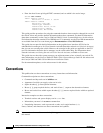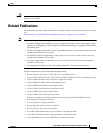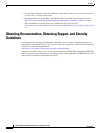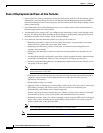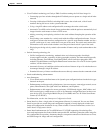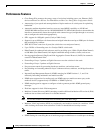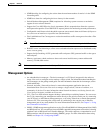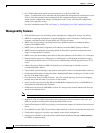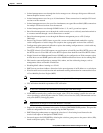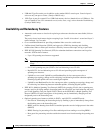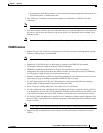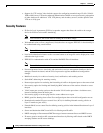
1-3
Catalyst 2960 and 2960-S Switch Software Configuration Guide
OL-8603-09
Chapter 1 Overview
Features
• Cisco FlexStack technology on Catalyst 2960-S switches running the LAN base image for
–
Connecting up to four switches through their FlexStack ports to operate as a single switch in the
network.
–
Creating a bidirectional 20-Gb/s switching fabric across the switch stack, with all stack
members having full access to the system bandwidth.
–
Using a single IP address and configuration file to manage the entire switch stack.
–
Automatic Cisco IOS version-check of new stack members with the option to automatically load
images from the stack master or from a TFTP server.
–
Adding, removing, and replacing switches in the stack without disrupting the operation of the
stack.
–
Provisioning a new member for a switch stack with the offline configuration feature. You can
configure in advance the interface configuration for a specific stack member number and for a
specific switch type of a new switch that is not part of the stack. The switch stack retains this
information across stack reloads whether or not the provisioned switch is part of the stack.
–
Displaying stack-ring activity statistics (the number of frames sent by each stack member to the
ring).
• Switch clustering technology for
–
Unified configuration, monitoring, authentication, and software upgrade of multiple,
cluster-capable switches, regardless of their geographic proximity and interconnection media,
including Ethernet, Fast Ethernet, Fast EtherChannel, small form-factor pluggable (SFP)
modules, Gigabit Ethernet, and Gigabit EtherChannel connections. For a list of cluster-capable
switches, see the release notes.
–
Automatic discovery of candidate switches and creation of clusters of up to 16 switches that can
be managed through a single IP address.
–
Extended discovery of cluster candidates that are not directly connected to the command switch.
• Stack troubleshooting enhancements
• Auto Smartports
–
Cisco-default and user-defined macros for dynamic port configuration based on the device type
detected on the port.
–
Enhancements to add support for global macros, last-resort macros, event trigger control, access
points, EtherChannels, auto-QoS with Cisco Medianet, and IP phones.
–
Enhancements to add support for macro persistency, LLDP-based triggers, MAC address and
OUI-based triggers, remote macros as well as for automatic configuration based on these two
new device types: Cisco Digital Media Player (Cisco DMP) and Cisco IP Video Surveillance
Camera (Cisco IPVSC).
For information, see the Auto Smartports Configuration Guide.
• Smart Install to allow a single point of management (director) in a network. You can use Smart
Install to provide zero touch image and configuration upgrade of newly deployed switches and
image and configuration downloads for any client switches. For more information, see the Cisco
Smart Install Configuration Guide.
• Smart Install enhancements in Cisco IOS Release 12.2(55)SE supporting client backup files,
zero-touch replacement for clients with the same product-ID, automatic generation of the image list
file, configurable file repository, hostname changes, transparent connection of the director to client,
and USB storage for image and seed configuration.






